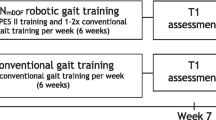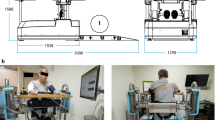Abstract
Robotic-assisted walking training has spread in recent years with positive results regarding its efficacy. However there are few information regarding the target people for a more effective robotic rehabilitation. The present study is aimed to investigate if possible demographic factors can influence robotic-assisted walking training. The study was performed in a neurorehabilitation setting. A total of 74 patients were randomized in robotic-assisted gait training abbreviated conventional therapy (RAGT) and floor-assisted gait training abbreviated conventional therapy intervention (FAGT). Outcome measure was the walking ability measured by Functional Ambulation Classifications (FAC). Results show that in RAGT group walking recovery was more effective for female than males (p=0.0048) and for patients over 65 years (≥65 yrs, p=0.040). This combined gender/age effect was not observed in FAGT group. Among demographic factors gender and age are critical for selecting stroke patients with higher chance of gait robotic gait therapy efficacy.
Access this chapter
Tax calculation will be finalised at checkout
Purchases are for personal use only
Preview
Unable to display preview. Download preview PDF.
Similar content being viewed by others
References
Langhammer, B., Stanghelle, J.K., Lindmark, B.: Exercise and health-related quality of life during the first year following acute stroke: a randomized controlled trial. Brain Inj. 22, 135–145 (2008)
Sullivan, K.J., Brown, D.A., Klassen, T., et al.: Physical Therapy Clinical Research Network (PTClinResNet). Effects of taskspecific locomotor and strength training in adults who were ambulatory after stroke: results of the STEPS randomized clinical trial. Phys. Ther. 87, 1580–1602 (2007)
Nilsson, L., Carlsson, J., Daniellson, A.: Walking training of patients with hemiparesis at an early stage after stroke: a comparison of walking training on a treadmill with body weight support and walking training on the ground. Clin. Rehabil. 15, 515–527 (2001)
Iosa, M., Morone, G., Fusco, A., Bragoni, M., Coiro, P., Multari, M., Venturiero, V., De Angelis, D., Pratesi, L., Paolucci, S.: Seven capital devices for the future of stroke rehabilitation. Stroke Res. Treat. 2012, 187965 (2012)
Masiero, S., Poli, P., Rosati, G., Zanotto, D., Iosa, M., Paolucci, S., Morone, G.: The value of robotic systems in stroke rehabilitation. Expert. Rev. Med. Devices (January 30, 2014)
Mayr, A., Kofler, M., Quirbach, E., Matzak, H., Fröhlich, K., Saltuari, L.: Prospective, blinded, randomized crossover study of gait rehabilitation in stroke patients using the Lokomat gait orthosis. Neurorehabil. Neural Repair 21, 307–311 (2007)
Morone, G., Bragoni, M., Iosa, M., De Angelis, D., Venturiero, V., Coiro, P., Pratesi, L., Paolucci, S.: Who benefit from robotic-assisted gait training? A randomized clinical trial in patients with subacute stroke. Neurorehabil. Neural Repair 25(7), 636–644 (2011)
Morone, G., Iosa, M., Bragoni, M., De Angelis, D., Venturiero, V., Coiro, P., Riso, R., Pratesi, L., Paolucci, S.: Who have durable benefit from robotic gait training?: a 2-year follow-up randomized controlled trial in patients with subacute stroke. Stroke 43(4), 1140–1142 (2012)
Bragoni, M., Broccoli, M., Iosa, M., et al.: Influence of psychologic features on rehabilitation outcomes in patients with subacute stroke trained with robotic-aided walking therapy. Am. J. Phys. Med. Rehabil. 92(10, suppl. 2), e16–e25 (2013)
Holden, M.K., Gill, K.M., Magliozzi, M.R.: Gait assessment for neurologically impaired patients: standards for outcome assessment. Phys. Ther. 66, 1530–1539 (1986)
Paolucci, S., Antonucci, G., Pratesi, L., Traballesi, M., Lubich, S., Grasso, M.G.: Functional outcome in stroke inpatient rehabilitation: predicting no, low and high response patients. Cerebrovasc. Dis. 8(4), 228–234 (1998)
Paolucci, S., Bragoni, M., Coiro, P., De Angelis, D., Fusco, F.R., Morelli, D., Venturiero, V., Pratesi, L.: Is sex a prognostic factor in stroke rehabilitation? A matched comparison. Stroke 37(12), 2989–2994 (2006)
Paolucci, S., Di Vita, A., Massicci, R., Traballesi, M., Bureca, I., Matano, A., Iosa, M., Guariglia, C.: Impact of participation on rehabilitation results: a multivariate study. Eur. J. Phys. Rehabil. Med. 48(3), 455–466 (2012)
Belda-Lois, J.M., Mena-del Horno, S., Bermejo-Bosch, I., et al.: Rehabilitation of gait after stroke: a review towards a top-down approach. J. Neuroeng. Rehabil. 8, 66 (2011), doi:10.1186/1743-0003-8-66 (review)
Author information
Authors and Affiliations
Editor information
Editors and Affiliations
Rights and permissions
Copyright information
© 2014 Springer International Publishing Switzerland
About this paper
Cite this paper
Morone, G. et al. (2014). Effectiveness of Robotic Assisted Walking Therapy: The Role of Age and Sex. In: Jensen, W., Andersen, O., Akay, M. (eds) Replace, Repair, Restore, Relieve – Bridging Clinical and Engineering Solutions in Neurorehabilitation. Biosystems & Biorobotics, vol 7. Springer, Cham. https://doi.org/10.1007/978-3-319-08072-7_83
Download citation
DOI: https://doi.org/10.1007/978-3-319-08072-7_83
Publisher Name: Springer, Cham
Print ISBN: 978-3-319-08071-0
Online ISBN: 978-3-319-08072-7
eBook Packages: EngineeringEngineering (R0)




